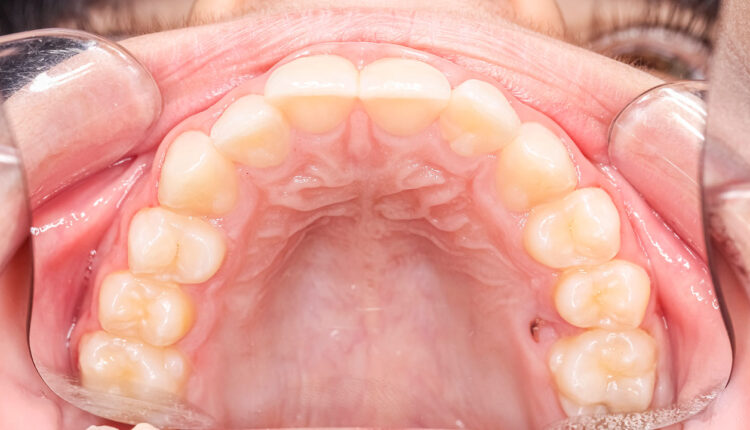
Navigating the Full-Arch Dilemma
Choosing between preserving natural teeth or opting for full-arch rehabilitation is a complex decision that demands a comprehensive evaluation of each patient’s dental history, risk factors, and long-term prognosis. Success hinges on careful interdisciplinary planning and the patient’s ability to maintain the chosen treatment over time.
A critical decision in full-arch rehabilitation is whether to extract the patient’s remaining teeth or preserve them. This choice requires careful consideration based on individual patient factors. Patients’ complete medical and dental history, both past and present, along with their daily oral hygiene practices, play vital roles in predicting the long-term prognosis and success of treatment. An additional consideration is the interdisciplinary collaboration between a prosthodontist and periodontist and/or oral surgeon to best manage the prosthetic and surgical components of the case. Ultimately, the sustainability of any dental treatment depends on the patient’s ability to maintain it over time.
Before recommending full-arch rehabilitation, clinicians should thoroughly assess several critical factors.
Dental History Factors
- Periodontal status and oral hygiene
- When evaluating patients for full-arch rehabilitation, their periodontal status and oral hygiene habits are crucial determinants. Severe periodontal diseases often indicate a poor long-term prognosis for natural teeth, potentially favoring full-arch prosthetic solutions. However, clinicians must identify the underlying cause of the periodontal disease.1
- Studies demonstrate that patients with advanced periodontal conditions face significantly higher risks of tooth loss and reduced implant success due to increased microbial burden and inflammatory responses.1-4
- Past, current, and future caries risk
- Multiple recurrent carious lesions and a history of failing restorations increase the likelihood of needing future restorative interventions, potential tooth loss, and possible implant-supported rehabilitation failure.1
- Conditions causing xerostomia, such as head and neck radiation or polypharmacy, automatically place patients in a high caries risk category. With remaining natural teeth likely requiring ongoing treatment, many patients opt proactively for complete extraction followed by implants to avoid future caries complications.
- Existing restorations and endodontic status
- Multiple failing restorations and endodontically treated teeth may suggest full-arch rehabilitation as a more sustainable long-term solution, though the causes of restoration failure must be thoroughly assessed. Conversely, well-maintained restorations accompanied by good oral hygiene may indicate that preserving natural teeth would benefit the patient.
- Occlusion and function
- Severe occlusal wear, collapsed vertical dimension, and parafunctional habits like bruxism may necessitate full-arch implant prostheses for predictable outcomes. However, these same factors might lead clinicians to recommend delayed implant loading rather than immediate loading protocols.
- Bone support and volume
- Severe ridge resorption or inadequate bone volume can challenge implant placement and may require grafting procedures. Some patients prefer to avoid the additional costs and extended healing time associated with grafting, making tilted implant approaches for full-arch prostheses an attractive alternative.5,6
By weighing periodontal status, caries risk, restoration integrity, occlusion, and bone support while collaborating across specialties, clinicians can create personalized full-arch treatment plans that balance immediate needs with long-term sustainability. Thoughtful case selection ultimately determines whether preservation or extraction offers the best path forward for each patient.
References
- Marchand F, Raskin A, Dionnes-Hornes A, et al. Dental implants and diabetes: conditions for success. Diabetes Metab. 2012;38:14-19.
- Tonetti MS, Chapple IL, Jepsen S, Sanz M. Primary and secondary prevention of periodontal and peri-implant diseases: Introduction to, and objectives of the 11th European Workshop on Periodontology consensus conference. J Clin Periodontol. 2015;42 Suppl 16:S1-4.
- Porter JA, von Fraunhofer JA. Success or failure of dental implants? A literature review with treatment considerations. Gen Dent. 2005;53:423-432.
- Chrcanovic BR, Albrektsson T, Wennerberg A. Periodontally compromised vs. periodontally healthy patients and dental implants: a systematic review and meta-analysis. J Dent. 2014;42:1509-1527.
- Esposito M, Grusovin MG, Felice P, Karatzopoulos G, Worthington HV, Coulthard P. The efficacy of horizontal and vertical bone augmentation procedures for dental implants — a Cochrane systematic review. Eur J Oral Implantol. 2009;2:167-184.
- Esposito M, Grusovin MG, Polyzos IP, Felice P, Worthington HV. Timing of implant placement after tooth extraction: immediate, immediate-delayed or delayed implants? A Cochrane systematic review. Eur J Oral Implantol. 2010;3:189-205.
This originally appeared in Chang B. The evolution of full-arch implant rehabilitation. Decisions in Dentistry. 2025;11(3):10-15.

